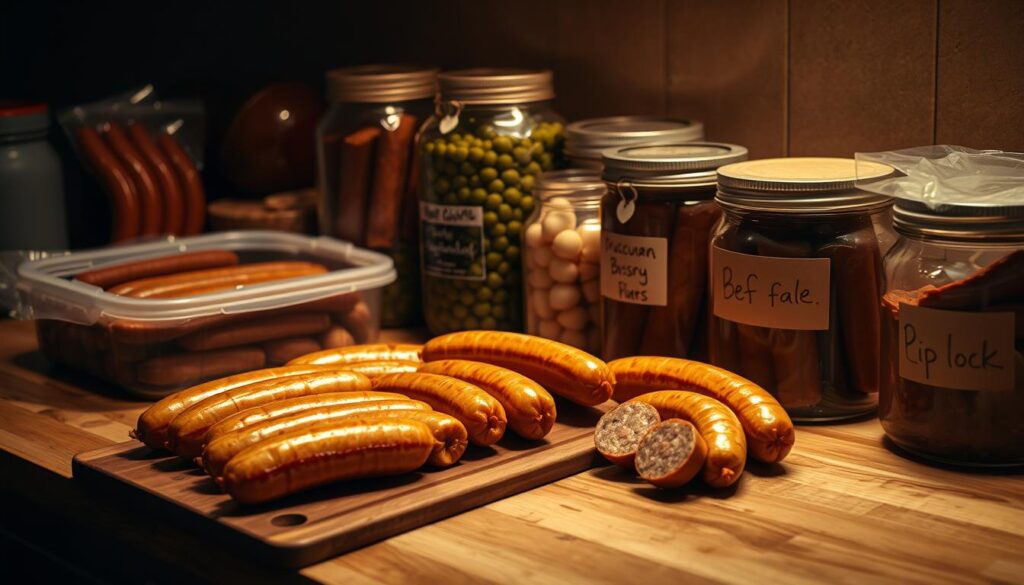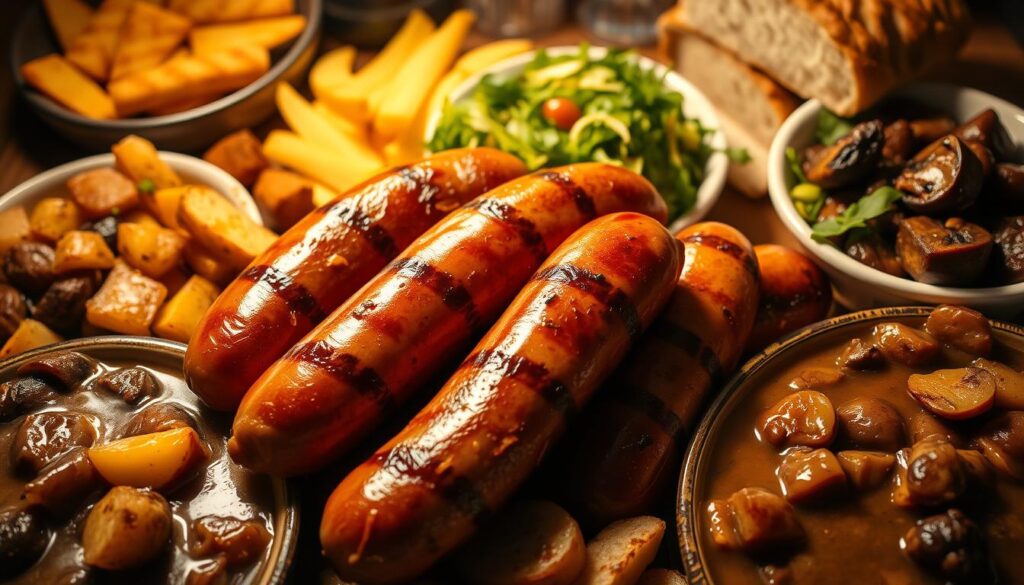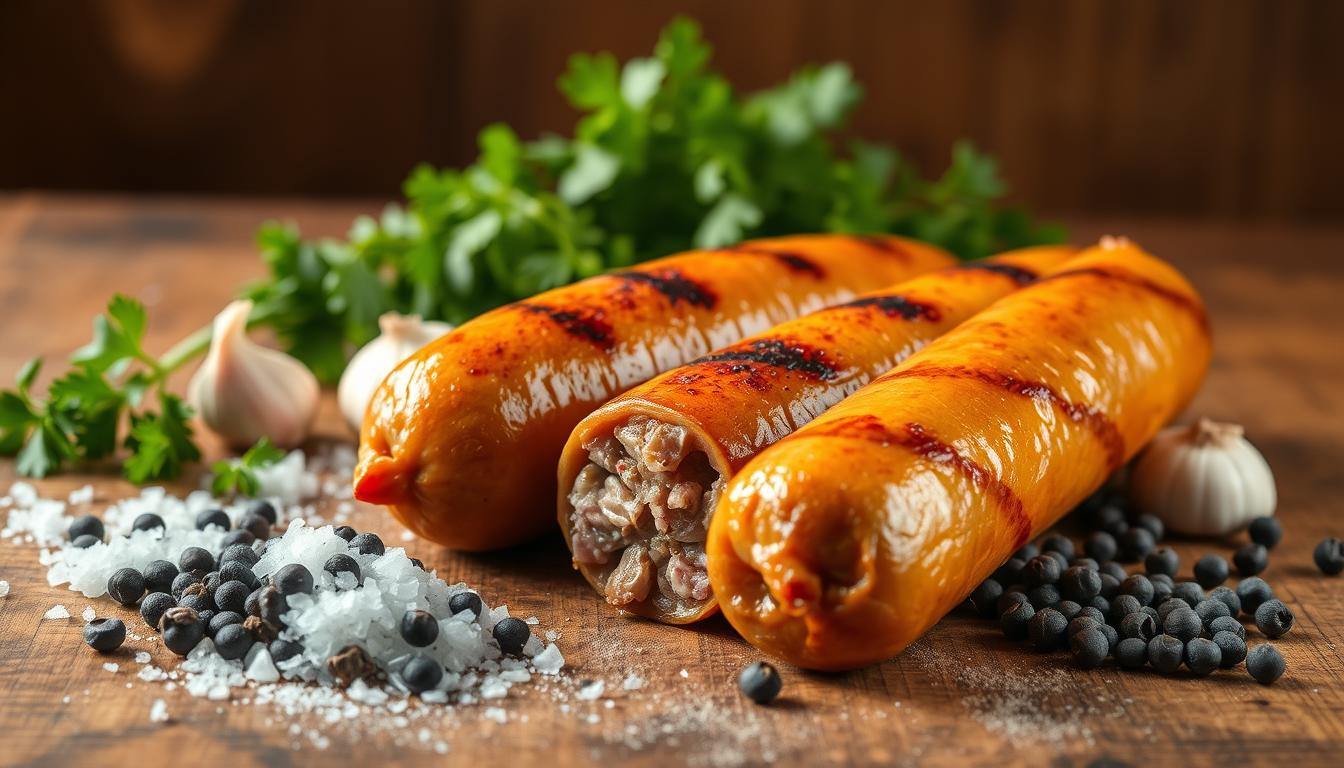The kitchen fills with a delicious smell as I cut into homemade beef sausage. Making your own beef sausage is more than cooking—it’s an art. It turns simple ingredients into a dish that’s full of flavor.
When you make your own beef sausage, you’re not just cooking a meal. You’re creating a special experience. With just 50 minutes of total time, you can make tasty sausage links. Each link has only 142 calories.
Whether you love cooking on weekends or are a home cooking enthusiast, making beef sausage is a skill to master. It will make your cooking better and impress your guests. You’ll turn ground beef into a delicious treat that’s healthier and tastier than store-bought.
Table of Contents
Essential Equipment and Ingredients
Making the best beef sausage recipe begins with the right tools and ingredients. If you’re new to making beef sausage at home, preparation is crucial. The right equipment can make a big difference in your cooking experience.
Must-Have Kitchen Tools
To make exceptional beef sausages, you’ll need some special tools:
- Meat Grinder with multiple dies (6mm and 10mm recommended)
- Kitchen Scale for precise measurements
- Sausage Stuffer
- Large Mixing Bowl
- Measuring Cups and Spoons
Quality Ingredient Selection
Choosing top-notch ingredients is key for the best beef sausage recipe. Use high-quality ground beef with a meat-to-fat ratio of 70:30. This ratio makes your sausages juicy and full of flavor.
| Ingredient | Recommended Quantity | Quality Indicator |
|---|---|---|
| Ground Beef | 1 pound | 70:30 fat content |
| Salt | 1.5 teaspoons | Kosher or sea salt |
| Dried Sage | 1.5 teaspoons | Fresh, high-quality |
| Brown Sugar | 2 teaspoons | Granulated |
| Water | 1/4 cup | Cool, clean |
Pro tip for home sausage makers: Keep your meat below 35°F before grinding. This helps keep the texture and ensures food safety. With the right tools and ingredients, you’ll be making professional-quality beef sausages in no time!
Preparing the Perfect Beef Sausage Meat Recipe
To make a tasty beef sausage recipe, you need to prepare carefully. Start by picking the right meat and keeping the temperature just right.
Choose ground beef with 85% lean and 15% fat. This mix makes your sausage juicy and full of flavor. Make sure everything stays cold to keep the texture right and stop bacteria from growing.
- Use 1 pound of ground beef
- Maintain ingredient temperature below 40°F
- Prepare mixing bowl and utensils in advance
When mixing your sausage meat, remember these important steps:
- Combine ground beef with your chosen spices
- Mix gently to avoid overworking the meat
- Test seasoning by cooking a small sample
| Ingredient | Quantity | Purpose |
|---|---|---|
| Ground Beef | 1 lb | Primary protein base |
| Kosher Salt | 1 tsp | Primary seasoning |
| Black Pepper | ½ tsp | Aromatic spice |
Pro tip: Work quickly and keep ingredients cold to maintain the best texture for your sausage meat.
Seasoning Secrets for Flavorful Results
Creating a delicious beef sausage recipe is all about seasoning. Your seasoning mix can turn regular meat into a culinary masterpiece. The right spices can make your sausages unforgettable.
Knowing the science of seasoning is key. Fat content is important – 20-30% fat keeps the meat moist and flavorful.
Traditional Spice Blends
Classic seasoning mixes have proven their worth. Here are the must-haves for your beef sausage:
- Salt: Essential for flavor
- Black pepper: Adds a touch of heat
- Garlic powder: Brings depth
- Onion powder: Adds complexity
- Paprika: Adds a mild smokiness
Custom Flavor Profiles
You can tailor your seasoning mix to your liking. Think about adding these:
- Ground coriander: Gives a citrusy note
- Red pepper flakes: For more heat
- Fennel seeds: Adds a hint of anise
- Dried herbs: Like rosemary or thyme
| Spice Category | Flavor Impact | Recommended Quantity |
|---|---|---|
| Salt | Primary flavor enhancer | 1-2% of meat weight |
| Black Pepper | Heat and complexity | 0.5-1% of meat weight |
| Garlic Powder | Aromatic depth | 0.25-0.5% of meat weight |
Pro tip: Let your seasoned meat rest for 30 minutes to 24 hours before cooking. This lets flavors fully absorb into the meat.
Step-by-Step Mixing and Stuffing
Making beef sausage at home needs careful mixing and stuffing. Your guide starts with a balanced meat mix for great flavor and texture.
Begin by mixing ground beef with chosen spices. Make sure to mix well, so seasonings spread evenly. Pro tip: Use cold meat and keep your mixture chilled to prevent fat separation.
- Chill meat mixture for at least 1 hour before stuffing
- Use clean, sanitized equipment
- Maintain consistent meat temperature
- Avoid overworking the meat mixture
For sausage casings, follow these steps:
- Rinse casings thoroughly with cool water
- Slide casings carefully onto sausage stuffer
- Fill casings slowly to prevent air pockets
- Twist links at desired lengths
Or, you can make loose sausage meat or patties. The goal is to keep meat consistency and seasoning balance.
Precision and patience are your best tools in crafting delicious homemade sausages.
Cooking Methods and Temperatures
Mastering the art of cooking beef sausages is key to making the best recipe. Different cooking methods can change flavor, texture, and safety. Knowing these techniques will help you make delicious sausages every time.
The secret to perfect sausages is the right internal temperature. For safety, your beef sausages must hit 165°F (74°C) inside. This ensures they’re cooked well while keeping them juicy and tasty.
Grilling Techniques
Grilling brings out amazing flavors in beef sausages. Here are some expert tips:
- Preheat grill to medium heat (around 350°F)
- Use indirect heat to prevent burning
- Turn sausages every 3-4 minutes
- Cook for 10-15 minutes total
Alternative Cooking Options
If you don’t have a grill, don’t worry. Here are other ways to cook your best beef sausage recipe:
| Cooking Method | Temperature | Cooking Time |
|---|---|---|
| Oven Baking | 350°F | 20-25 minutes |
| Pan-Frying | Medium Heat | 10-15 minutes |
| Air Fryer | 375°F | 12-15 minutes |
Pro tip: Always use a meat thermometer to check internal temperature and ensure perfectly cooked sausages!
“Cooking sausages is an art that requires patience and precision.” – Culinary Expert
Storage and Preservation Tips

Storing your homemade beef sausage right is key to keeping it fresh and safe. Knowing how to preserve it means you can enjoy it for longer.
Temperature is crucial when storing fresh homemade beef sausage. Keep it in the fridge at 32°F to 40°F to stop bacteria and keep it fresh. For the best taste and texture, use it within 2-3 days after making.
Refrigeration Guidelines
- Store cooked beef sausage within 2 hours of cooking
- Refrigerate for up to 3-4 days
- Use airtight containers to prevent moisture loss
Freezing Techniques
| Storage Method | Duration | Recommended Practices |
|---|---|---|
| Freezer Storage | Up to 3 months | Vacuum seal or wrap tightly in freezer paper |
| Optimal Quality | 1-2 months | Cook within first month for best flavor |
When reheating your stored homemade beef sausage, do it gently to avoid drying it out. Use a skillet over medium heat or warm it in the oven at 350°F until it reaches 160°F for safety.
Pro Storage Tips
- Label containers with preparation date
- Portion sausages before freezing for easier thawing
- Always check for signs of spoilage before consuming
By sticking to these storage and preservation tips, your homemade beef sausage will stay delicious and safe to eat for weeks.
Recipe Variations and Adaptations
Trying out different styles and dietary changes can turn your savory beef sausage recipe into a fun journey. Your beef sausage seasoning mix is super flexible. It lets you create unique flavors that match many tastes and health needs.
When making your beef sausage, think about these cool regional and dietary twists:
Global Flavor Inspirations
- Italian Style: Add fennel seeds, crushed red pepper, and fresh basil
- Mexican Chorizo-Inspired: Mix in smoked paprika, chili powder, and cumin
- German Bratwurst: Add caraway seeds and nutmeg
Dietary Modification Options
| Dietary Requirement | Recommended Modification |
|---|---|
| Low-Sodium | Reduce salt, use herbs for flavor |
| Gluten-Free | Use gluten-free breadcrumbs or almond flour |
| Keto-Friendly | Replace breadcrumbs with ground pork rinds |
| Lean Protein | Use ground turkey or chicken instead of beef |
Your homemade beef sausage is a blank canvas for creativity. Try different spices, meats, and methods. Make a recipe that shows off your taste and dietary choices.
Serving Suggestions and Pairings

Turn your beef sausage recipe into a memorable meal with creative serving ideas. Whether it’s for breakfast, lunch, or dinner, the right sides can make your dish stand out. They can take it from simple to spectacular.
Side Dish Recommendations
Here are some tasty side dishes to go with your beef sausages:
- Vegetable Sides:
- Zucchini Salad
- Grilled Vegetable Kebabs
- Quinoa-Stuffed Butternut Squash
- Roasted Carrots
- Carb-Based Options:
- Greek Couscous Salad
- BBQ’d Sweet Corn
- Mac and Cheese
- Pineapple Baked Beans
Cheese and Beverage Pairings
Make your beef sausage even better with the right cheese and drinks:
| Cheese Pairing | Beverage Recommendation |
|---|---|
| Sharp Cheddar | Craft Beer |
| Colby Jack | Red Wine |
| Smoked Gouda | Robust Red Blend |
Pairing your beef sausage with the right sides, cheeses, and drinks makes it a culinary adventure. Try these ideas to impress your family and friends.
Troubleshooting Common Issues
When you start making sausage at home, you might face some challenges. These can affect the taste and texture of your homemade beef sausage. It’s important to know how to handle these issues to make great sausages.
Texture problems often come from how you handle the meat. Using an 80/20 ground beef mix is best for avoiding dry sausages. Keep the meat cold, between 0-5º C, to ensure even fat distribution. If your sausage feels too tight, mix it for less than 5 minutes to avoid overworking.
Texture Problems
When you’re learning to make sausage, watch for texture issues. A coarser grind helps keep the meat structure right, which is good for chili or stews. Make patties about 1 inch thick to avoid toughness and ensure even cooking.
Flavor Adjustments
Seasoning is key when making your own sausage. If you don’t season enough, even the best beef can taste bland. Do taste tests before stuffing your sausages. Balance salt and spices carefully. Try small batches to find the perfect flavor for your sausages.
FAQ
What equipment do I need to make beef sausage at home?
You’ll need a meat grinder or pre-ground beef, mixing bowls, and a kitchen scale. You might also need a sausage stuffer and casings for links. For beginners, a food processor can be a good substitute for a meat grinder. Make sure your equipment is clean and cold to keep food safe and right in texture.
What’s the ideal fat content for beef sausage?
Aim for 20-30% fat for juicy and flavorful sausages. This fat ratio keeps the meat moist and prevents it from becoming dry. Use chuck or ground beef with 70-80% lean meat for the best results.
How do I prevent my sausages from becoming dry or tough?
Keep everything cold and avoid overmixing the meat. Don’t cook at too high a temperature. Use a meat thermometer to check the temperature. Adding a bit of moisture, like milk or wine, in your seasoning mix can also help.
Can I make beef sausages without casings?
Yes, you can make sausage patties or use the meat as a loose ground sausage. This is great if you don’t have sausage stuffing equipment or prefer a more versatile option.
How long can I store homemade beef sausages?
Raw sausages can be refrigerated for 1-2 days or frozen for up to 3 months if sealed well. Cooked sausages last 3-4 days in the fridge and up to 2 months in the freezer. Always use airtight containers or vacuum-sealed bags for best storage.
What are some essential spices for beef sausage?
Essential seasonings include salt, black pepper, garlic powder, paprika, and dried herbs like thyme or sage. For more complex flavors, try red pepper flakes, fennel seeds, or dried chili powder.
Is it safe to make sausages at home?
Yes, as long as you follow food safety guidelines. Use fresh, high-quality meat, keep everything clean and cold, and cook sausages to 160°F (71°C) to kill harmful bacteria.
Can I modify the recipe for dietary restrictions?
Definitely! You can make low-sodium versions by reducing salt, use leaner beef for lower-fat options, or try different seasonings for gluten-free or specific dietary needs. Homemade sausages are very adaptable.
Source Links
- Quick and Easy Beef Sausage Recipes for Busy Weeknights – https://recipechefoliver.com/beef-sausage-recipes/
- How to Make the Perfect Beef Sausage Recipes at Home – https://www.preparationrecipe.com/beef-sausage-recipes/
- How To Make Beef Sausage Recipes, Easy & Quick in 30 munites – https://www.familyfavrecipes.com/how-to-make-beef-sausage-recipes/
- Homemade Beef Breakfast Sausage – https://thecookful.com/beef-breakfast-sausage/
- How to Make Sausage At Home – https://www.smokedbbqsource.com/how-to-make-sausage-at-home/
- Easy Beef Sausage Recipe – Healthy Recipes Blog – https://healthyrecipesblogs.com/homemade-sausage/
- Beef and Italian Sausage Lasagna – https://eatsimplefood.com/beef-sausage-lasagna/
- The Secret Of How To Cook Sausages? – https://creole.net/blog/the-secret-of-how-to-cook-sausages/?srsltid=AfmBOoqVSF5_nJTACLp7V0pcbCUKZhSpeKkS2nwWHD9M3oe33g4hEdnr
- Elevate Your Grilling with Butcher BBQ- Essential Seasoning and Rubs – https://butcherbbq.com/blogs/news/elevate-your-game-with-butcher-bbqs-essential-seasoning-and-rubs?srsltid=AfmBOoo2-f75otjqZaZwb0ePDdKkWZrGI3x5GEtmuivlqeo7kbHGtHzU
- Easy Sausage & Herb Stuffing Recipe – Once Upon a Chef – https://www.onceuponachef.com/recipes/sausage-herb-stuffing.html
- Sage & Onion Sausagemeat Stuffing – https://feastgloriousfeast.com/sausagemeat-stuffing/
- Easy Sausage Meat Stuffing With Sage and Onion – https://beatthebudget.com/recipe/sausage-meat-stuffing/
- How to Cook Sausage Properly Guide | High Caliber Products – https://highcaliberproducts.com/how-to-cook-sausage-properly-a-comprehensive-guide/
- How to Cook Sausage: The 5 Best Ways – https://www.gourmetfoodstore.com/how-to-cook-sausage-16350
- Beef Sausage 101: Types, Tastes, and Tips – https://simpsonsmeats.com/blogs/blog/beef-sausage-101-types-tastes-and-tips
- Summer sausage and deli-style meats – https://extension.oregonstate.edu/food/preservation/summer-sausage-deli-style-meats
- Preserving Meats – Hoosier Hill Farm – https://www.hoosierhillfarm.com/tips/preserving-meats/?srsltid=AfmBOopXyds5sq-pcLHNNGs7oIye75_1EY1WLiHZLoPjh1Z0Ge0Ngutg
- 27 Ways to Make Slow-Cooker Sausage – https://www.tasteofhome.com/collection/slow-cooker-sausage-recipes/?srsltid=AfmBOoqZXF8OYfKNzcv1tE6L4FQ8W4xF_Rb-Th4xGNlzVASUptK5cRa0
- Homemade Italian Sausage – https://www.feastingathome.com/homemade-italian-sausage/
- Easy Sausage Hotpot – https://www.effortlessfoodie.com/sausage-hotpot/
- The Best Sides to Go With Sausage – Premio Foods – https://www.premiofoods.com/best-sides-to-go-with-sausage/
- Sausage and Cheese Pairings Made Easy – https://www.jonesdairyfarm.com/blog/sausage-and-cheese-pairings-made-easy/
- What To Serve With Kielbasa: A Guide to Perfect Pairings – https://veselka.com/blogs/articles/what-goes-with-kielbasa-a-guide-to-perfect-pairings
- Mixing meat – https://www.meatsandsausages.com/sausage-making/mixing-meat
- Mistakes Everyone Makes With Ground Beef – Chowhound – https://www.chowhound.com/1631058/ground-beef-common-mistakes-home-cook/
- 10 Healthy Recipe: Chicken, Apple, and Bacon Sausage – https://www.verywellfit.com/how-to-make-your-own-healthy-sausage-3495928









